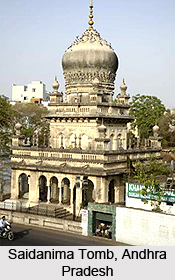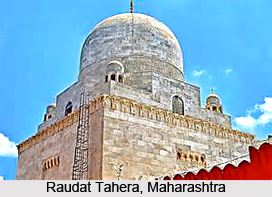 Tombs in India were generally dedicated to the Muslim rulers who ruled India for centuries. Basically, there was no indigenous tradition of building tomb in India. The ashes of the dead were carried away by the sacred rivers. Even in Islam, tomb building was restricted. The building of tomb to glorify a grave by constructing a building over it was forbidden for centuries, as this would run counter to the equality of all men in death. By the time of the Muslim invasions of India in the 12th century, the proscription against tomb building was extensively ignored. In India a Muslim tomb or `qabristan` mainly comprises a single vaulted domed chamber, in the centre of which is the cenotaph. Below lays the mortuary chamber or maqbara, with the grave or `qabr` in the centre. Occasionally, the west wall possesses a `mihrab`. Often some bigger tombs have mosques attached as separate buildings, the whole ensemble being contained within an enclosure or garden and called a `rauza`.
Tombs in India were generally dedicated to the Muslim rulers who ruled India for centuries. Basically, there was no indigenous tradition of building tomb in India. The ashes of the dead were carried away by the sacred rivers. Even in Islam, tomb building was restricted. The building of tomb to glorify a grave by constructing a building over it was forbidden for centuries, as this would run counter to the equality of all men in death. By the time of the Muslim invasions of India in the 12th century, the proscription against tomb building was extensively ignored. In India a Muslim tomb or `qabristan` mainly comprises a single vaulted domed chamber, in the centre of which is the cenotaph. Below lays the mortuary chamber or maqbara, with the grave or `qabr` in the centre. Occasionally, the west wall possesses a `mihrab`. Often some bigger tombs have mosques attached as separate buildings, the whole ensemble being contained within an enclosure or garden and called a `rauza`.
The tombs in India of men and women can be differentiated easily. Generally, the tomb of men bears a long, arched ridge along the top which slopes slightly north to south, while the tomb of women possesses flat tops. The body lies with the head to the north, lying on the right-hand side, with the face towards Mecca. A vault is believed to be essential since the body can sit up and reply to the angels of the grave.
Tomb of Adham Khan
Adham Khan`s Tomb was erected in the year 1561 and is preserved by the Archaeological Survey of India. Adham Khan, Akbar`s general was buried in this structure and is situated in Mehrauli in Delhi, particularly in the northern section of the Qutub Minar. Khan was his wet nurse Maham Anga`s son.
Hazira Maqbara Tomb
Graves of the teacher of Salim who was Akbar`s successor and also grave of Naurang Khan, another son of Akbar are present in the Hazira Maqbara Tomb which had been created in 1586. Its architecture follows the typical Mughal architectural characteristics.
 Tomb of Mariam-uz-Zamani
Tomb of Mariam-uz-Zamani
Mariam-uz-Zamani or Heer Kunwari, also known as Jodha Bai was the Rajput wife of Akbar who was buried in the Tomb of Mariam-uz-Zamani. It was established between 1623 and 1627 CE. It is present at Sikandra, near Agra, Uttar Pradesh.
Tomb of Itimad-ud-Daulah
Tomb of Itimad-ud-Daulah is based in Agra, Uttar Pradesh and was constructed in the period between 1622 and 1628. Exquisite marble ornamentation, along with red sandstone was utilized to beautify the tomb and later white marble and pietra dura were applied.
Bibi ka Maqbara Tomb
Bibi ka Maqbara was constructed between 1651 and 1661 CE by emperor Aurangzeb for his wife, Dilras Banu Begum in Aurangabad District, Maharashtra. After her death she was referred to as `Rabia-ud-Daurani`. This tomb is structurally quite similar to the Taj Mahal.
Sheikh Chilli`s Tomb
The Tomb of Sheikh Chilli or Abd-ur-Rahim Abdul-Karim Abd-ur-Razak is present in Thanesar, Haryana. He used to be Dara Shikoh`s Qadiriyya Sufi tutor and his tomb is adorned with Persian architectural features. A `madrasa` was also built in its premises.
Saidanima Tomb
Also known as Saidani Maa Ki Dargah or `Maa Saheba Ke Dargah`, the Saidanima Tomb was created in 1883 AD by Nawab Abdul Haq Diler Jung who served as an official inside the royal court of the 6th Nizam of Hyderabad in the memory of his deceased mother Saidani Maa. The tomb is located in Hyderabad, Andhra Pradesh.
Raudat Tahera Mausoluem
The mausoleum of Raudat Tahera contains the graves of Syedna Mohammed Burhanuddin and also his father who was Dr. Syedna Taher Saifuddin. Its construction began on 10th December, 1968. It exists in Bhendi Bazaar, Maharashtra.
Other Tombs in India
Visitors can explore many other Indian tombs which include Barakhamba in Delhi, Qadam Sharif tomb in Delhi, Chausath Khamba, Delhi, Bahu Begum ka Maqbara in Uttar Pradesh, Gulab Bari in Uttar Pradesh and numerous others.
Some of the prominent tombs are known as dargahs, a Persian word which means, a palace or a court. They often bear the remains of Sufi sheikhs and are places of pilgrimage on the anniversary of the death of the saint, the urs. As spiritual disciples and descendants of the sheikh sought to be buried near their master, dargahs often possess a great concentration of tombs and graves, which militates against any sort of architectural cohesion. Sometimes a whole set of monuments in different styles and forms ranging over a period of 500 years can be found juxtaposed, obscuring the principal tomb.
 The reason for this crowding against the `qibla` wall is the belief in Baraka, a spiritual energy coming out from the grave of a saint or holy man. Great importance is given to this psychic force. The tomb of Humayun, tomb of Akbar, Jahangir and above all, Shah Jahan rank with the Pyramids as the greatest funerary monuments in the world, but the concept of the tomb in a walled enclosure predated the Mughals. The tomb of Sher Shah Suri is also one of the notable tombs in India.
The reason for this crowding against the `qibla` wall is the belief in Baraka, a spiritual energy coming out from the grave of a saint or holy man. Great importance is given to this psychic force. The tomb of Humayun, tomb of Akbar, Jahangir and above all, Shah Jahan rank with the Pyramids as the greatest funerary monuments in the world, but the concept of the tomb in a walled enclosure predated the Mughals. The tomb of Sher Shah Suri is also one of the notable tombs in India.
The site of a monumental tomb at the centre of an enclosed garden alluded to basic cosmological ideas. In essence it was the Garden of Eden that was lost to man through original sin, but it was also the Garden of Paradise. Inscribed over the entrance to the tomb of Akbar at Sikandra are the words; `these are the Gardens of Eden: enter them to dwell therein eternally`. The garden was a microcosm of the physical world, maintained symmetrically and axially in accordance with modern cosmological beliefs. At the centre is the tomb, the material universe, crowned by a dome, the symbol of eternity.



















